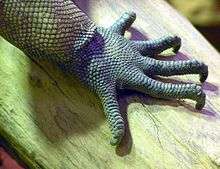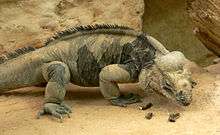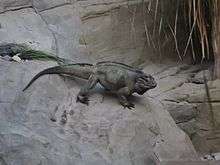Rhinoceros iguana
| Rhinoceros iguana | |
|---|---|
 | |
| Male rhinoceros iguana, Pedernales Province, Dominican Republic, 2007 | |
| Scientific classification | |
| Kingdom: | Animalia |
| Phylum: | Chordata |
| Class: | Reptilia |
| Order: | Squamata |
| Suborder: | Iguania |
| Family: | Iguanidae |
| Genus: | Cyclura |
| Species: | C. cornuta |
| Binomial name | |
Cyclura cornuta
| |
The rhinoceros iguana also known as "Goliath Dragons" (Cyclura cornuta) is a threatened species of lizard in the family Iguanidae that is primarily found on the Caribbean island of Hispaniola, shared by the Republic of Haiti and the Dominican Republic. They vary in length from 60 to 136 centimetres (24 to 54 in) and skin colors range from a steely gray to a dark green and even brown. Their name derives from the bony-plated pseudo-horn or outgrowth which resembles the horn of a rhinoceros on the iguana's snout.
Taxonomy
The rhinoceros iguana is a species of lizard belonging to the genus Cyclura. The generic name (Cyclura) is derived from the Ancient Greek cyclos (κύκλος) meaning "circular" and ourá (οὐρά) meaning "tail", after the thick-ringed tail characteristic of all Cyclura.[1] The rhinoceros iguana's specific name, cornuta, is the feminine form of the Latin adjective cornutus, meaning "horned" and refers to the horned projections on the snouts of males of the species. The species was first identified by Pierre Joseph Bonnaterre in 1789.[2][3]
In addition to the nominate race (Cyclura cornuta cornuta) found on Hispaniola, there are two other subspecies of Cyclura cornuta, the Mona ground iguana (Cyclura cornuta stejnegeri) and the Navassa Island iguana (Cyclura cornuta onchiopsis), although the latter subspecies is believed to be extinct in the wild.[3][4]
Anatomy and morphology
The rhinoceros iguana, like other members of the genus Cyclura, is a large-bodied, heavy-headed lizard with strong legs and a vertically flattened tail.[5] A crest of pointed horned scales extends from the nape of their neck to the tip of their tail.[5] Their color is a uniform gray to brown drab.[5] Most adults weigh 4.56 kilograms (10.1 lb) to 9 kilograms (20 lb)[6]
These iguanas are characterized by the growth of bony prominent tubercles on their snouts which resemble horns.[7] Dr. Thomas Wiewandt, who spent an extended period on Mona Island studying Cyclura cornuta stejnegeri, suggested that the horns, along with lateral spines and prominent parietal bulges, function as protective armor against sharp rocks or as defensive tools to facilitate the escape of males from the grasp of one another.[7][8] Males possess an adipose pad in the form of a helmet on the occipital region of the head, and a large dewlap. This species, like other species of Cyclura, is sexually dimorphic; males are larger than females, and have more prominent dorsal crests and "horns" in addition to large femoral pores on their thighs, which are used to release pheromones.[9][10]
Distribution and habitat

Ranging throughout Hispaniola, Haiti and the Dominican Republic; rhinoceros iguana populations are stable only on Isla Beata and the extreme of the Barahona Peninsula inside Parque Nacional Jaragua.[2][5] There are moderately dense populations in the southeastern region of Haiti and its offshore islands including the saltwater lake of Etang Saumatre. Populations in Haiti are even more endangered due to the deforestation and human clearing practices. In general, the iguanas are found most abundantly in, although not restricted to, scrub woodland, dry forests characterized by xeric, rocky habitats of eroded limestone in coastal terraces and lowlands of the mainland and several offshore islands and small cays in a variety of subtropical life zones and habitat types.[2][5] An individual was photographed on May 4, 2008 on the Limbe Island in Northern Haiti. It had been caught by a group of fishermen from Bas-Limbe, Bord de Mer village. The rhinoceros iguanas caught on Limbe Island are eaten by the local population. This sighting represents a new area previously not thought to be in the range of Cyclura cornata.
The rhinoceros iguana is a diurnal species living primarily in rocky outcroppings with little vegetation for cover.[2][5] Although quick to flee when attacked or threatened, they will aggressively attack by biting and repeatedly striking with their thick tail if cornered.[5]
|
Diet

The rhinoceros iguana, like most Cyclura species is primarily herbivorous, consuming leaves, flowers, berries, and fruits from different plant species.[9] A study in 2000 by Dr Allison Alberts of the San Diego Zoo revealed that seeds passing through the digestive tracts of Cycluras germinate more rapidly than those that do not.[11][12] These seeds in the fruits consumed by cycluras have an adaptive advantage by sprouting before the end of very short rainy seasons.[12] The rhinoceros iguana is also an important means of distributing these seeds to new areas (particularly when females migrate to nesting sites) and, as the largest native herbivores of their island's ecosystem, they are essential for maintaining the balance between climate and vegetation.[12] Rhinoceros iguanas do appear to be opportunistic carnivores as individual animals have been observed eating small lizards, snakes, and insects.[5]
Mating
Male rhinoceros iguanas, unlike other members of the genus Cyclura, reach sexual maturity at four to five years of age.[9] Females become sexually mature at two to three years of age.[5] Male rhinoceros iguanas are territorial and the most aggressive males will have the largest range of territory.[2] Mating takes place at the beginning of, or just prior to, the first rainy season of the year (May to June) and lasts for two to three weeks.[2][9] Females lay from 2 to 34 eggs, with an average clutch size of 17, within 40 days.[9] Females guard their nests for several days after laying their eggs, and incubation lasts approximately 85 days.[2] It has been noted that their eggs are among the largest lizard eggs produced in the world.[9]
Endangered status

Although rhinoceros iguanas are the most common species of Cyclura kept in captivity there remain approximately 10-16,000 of these animals in the wild.[2] A successful breeding program existed at the Parque Zoológico Nacional of the Dominican Republic (ZooDom) from 1974 to 1994, with an average of 100 babies hatching annually.[2] These efforts included reintroductions of captive-bred "head-started" young to several protected areas in the southwest Dominican Republic in order to reduce the odds of predation by snakes and feral animals such as mongoose or cats.[2] The program has not continued since 1995, due to an administrative change at the zoo.[2]
As of 2009, a reintroduction of rhinoceros iguanas on the Samana Peninsula is planned by the Iguanario de los Tocones.[13]
Captivity

The rhinoceros iguana is well established in captivity, both in public and private collections.[9] As of 2007, rhinoceros iguanas in captivity throughout the United States total 39 males, 32 females, and 36 undetermined individuals at 20 zoological institutions, with an additional 533 animals of unassigned subspecies, reported by seven American Zoological and Aquarium Association institutions.[2] The actual number may be much higher considering animals kept at European and Asian zoos and the many kept as pets in private collections.[2] As a result, the demand for wild-caught animals to supply zoos and the pet trade has been reduced.[2][9]
Despite these numbers, making them the most numerous species of Cyclura, they are still considered a CITES (Convention on International Trade in Endangered Species) protected animal.[3]
References

- ↑ Sanchez, Alejandro. "Family Iguanidae: Iguanas and Their Kin". Father Sanchez's Web Site of West Indian Natural History Diapsids I: Introduction; Lizards. Kingsnake.com. Retrieved November 26, 2007.
- 1 2 3 4 5 6 7 8 9 10 11 12 13 14 Ottenwalder, J. (1996). "Cyclura cornuta". IUCN Red List of Threatened Species. Version 2006. International Union for Conservation of Nature. Retrieved September 9, 2007.
- 1 2 3 Hollingsworth, Bradford D. (2004). The Evolution of Iguanas: An Overview of Relationships and a Checklist od Species. Iguanas: Biology and Conservation. University of California Press. pp. 35–39. ISBN 978-0-520-23854-1.
- ↑ Blair, David, Navassa Island Iguana, archived from the original on 10 August 2007, retrieved 7 October 2007
- 1 2 3 4 5 6 7 8 9 Massimo Capula; Behler (1989). Simon & Schuster's Guide to Reptiles and Amphibians of the World. New York: Simon & Schuster. ISBN 0-671-69098-1.
- ↑ "Rhinoceros Iguana". Sea World. Retrieved 20 October 2009.
- 1 2 Powell, Robert (1 August 2000), "Horned Iguanas of the Caribbean", Reptile and Amphibian Hobbyist, 5 (12)
- ↑ Wiewandt, T.A. (1977). "Ecology, behavior, and management of the Mona Island ground iguana Cyclura stejnegeri". Ph.D. Thesis. Cornell University: 330.
- 1 2 3 4 5 6 7 8 De Vosjoli, Phillipe; David Blair (1992), The Green Iguana Manual, Escondido, California: Advanced Vivarium Systems, ISBN 1-882770-18-8
- ↑ Martins, Emilia P.; Lacy, Kathryn (2004), "Behavior and Ecology of Rock Iguanas,I: Evidence for an Appeasement Display", Iguanas: Biology and Conservation, University of California Press, pp. 98–108, ISBN 978-0-520-23854-1
- ↑ Derr, Mark (2000-10-10), "In Caribbean, Endangered Iguanas Get Their Day", New York Times Science Section
- 1 2 3 Alberts, Allison; Lemm, Jeffrey; Grant, Tandora; Jackintell, Lori (2004), "Testing the Utility of Headstarting as a Conservation Strategy for West Indian Iguanas", Iguanas: Biology and Conservation, University of California Press, p. 210, ISBN 978-0-520-23854-1
- ↑ Iguanario de los Tocones website, retrieved 2009 January 28, http://www.iguanario.com/Who_are_we.html
External links
| Wikimedia Commons has media related to Cyclura cornuta. |
| Wikispecies has information related to: Cyclura cornuta |
- Profile on Cyclura.com
- Rhinoceros Iguanas at the Nashville Zoo
- Iguana at PhotoSig.com
- Iguanario de los Tocones, Dominican Republic


